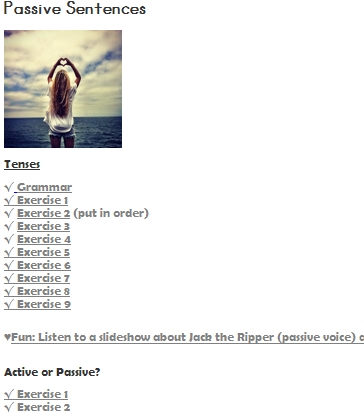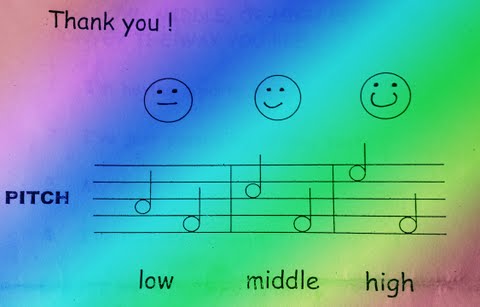Tired of always looking for exercises for different grammar points I have started putting together everything I need, related to a certain point of grammar, on the same page.
I need, related to a certain point of grammar, on the same page.
Today I have uploaded The Passive. On the same page I have put together Grammar and Exercises for pre-intermediate/intermediate levels. Exercises cover practice for:
♥ basic and more complex tenses,
♥ active to passive and the other way round,
♥ questions in passive sentences,
♥ sentences with two objects,
♥ the prepositions by and with,
♥ impersonal passive (it is said/believed) ,
♥ be supposed to
♥ have sth done
Hope it is as helpful to you as it is to me.Now, I can safely take them to the computer room, ask them to go to this url where they’ll find everything they need to work on. Very useful too, to do as homework or revise just before exams at their own pace.
Click on the picture to give it a go
Below I have embedded A MentorMob Playlist with all the Grammar and Exercises already published. More will follow; I hope!
 to revise for finals, MentorMob flashed in my mind and I saw the light. ;).
to revise for finals, MentorMob flashed in my mind and I saw the light. ;). a written test – I have tried this little trick plenty of times, especially when trying to learn long lists of irregular verbs, but when your target is learning to speak a language, trust me , this little trick won’t work.
a written test – I have tried this little trick plenty of times, especially when trying to learn long lists of irregular verbs, but when your target is learning to speak a language, trust me , this little trick won’t work. You might not believe it but it has been raining nonstop for more than two months now and I feel I need some sun to cheer me up. Added to this is the fact that I’ve been working mornings, afternoons, evenings and also two weekends in a row. Only today, I am quickly writing this post to leave again to go to work .
You might not believe it but it has been raining nonstop for more than two months now and I feel I need some sun to cheer me up. Added to this is the fact that I’ve been working mornings, afternoons, evenings and also two weekends in a row. Only today, I am quickly writing this post to leave again to go to work . superlative sentences as they can about the people in their classroom. At the end of the time period, have one group share their sentences. If another group has the same sentence as the first group, both groups should cross that statement off their list. Continue until all groups have read all of their statements and any duplicates are eliminated. The group with the most statements remaining wins.
superlative sentences as they can about the people in their classroom. At the end of the time period, have one group share their sentences. If another group has the same sentence as the first group, both groups should cross that statement off their list. Continue until all groups have read all of their statements and any duplicates are eliminated. The group with the most statements remaining wins. Once the sentences are completed, each person should write a list of the family members who appeared in their sentences. Students in pairs exchange the lists of people but keep their sentences to themselves. Each person should ask questions about their partner’s family and try to match each person to their superlative adjective. For example, a person might ask, “Is Lucas the oldest person in your family?” The other person should answer with a yes or an explanation. “No, Lucas is only four years old.” Give students time enough to ask each other questions, and then see who in your class figured out the most family member qualities!
Once the sentences are completed, each person should write a list of the family members who appeared in their sentences. Students in pairs exchange the lists of people but keep their sentences to themselves. Each person should ask questions about their partner’s family and try to match each person to their superlative adjective. For example, a person might ask, “Is Lucas the oldest person in your family?” The other person should answer with a yes or an explanation. “No, Lucas is only four years old.” Give students time enough to ask each other questions, and then see who in your class figured out the most family member qualities!
